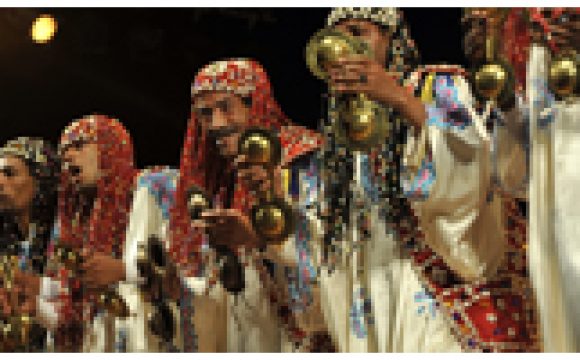
This article originally appeared on the Michael Valentine Studio website – music photography and reviews:
http://www.michaelvalentinestudio.com/soul_other/festival_gnaoua_introduction08/index.php
Day one: 26/06/08
The 11th edition of the ‘Festival Gnaoua’ in Essaouira, on Morocco’s Atlantic coast has exploded into life; every street and square in the Medina reverberates with the infectious beats and rhythms of Gnaoua music, punctuated by the sound of the sea; cries of seagulls, and the call to prayer of the Muezzin from the mosques, all of which seem to blend perfectly with the drum beats of the Gnaoua…. In addition to the numerous official stages and venues, which host performances from the afternoon throughout most of the night, impromptu jam sessions are happening on almost every street corner; young Moroccans roam the streets singing and playing & there is no corner of the town where music cannot be heard, 24 hours a day.
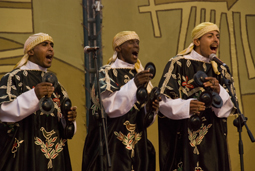 Almost all of the concerts in the Festival are free, and enthusiastic crowds of all ages and from all walks of life provide a noisy and energetic accompaniment to all the performances. There is an incredibly joyful, and uplifting vibe here; one that reminds me of what music is really all about. Festival Artistic Director Loy Ehrlich describes it as ‘the power of music to transport us to a higher plane of consciousness’……
Almost all of the concerts in the Festival are free, and enthusiastic crowds of all ages and from all walks of life provide a noisy and energetic accompaniment to all the performances. There is an incredibly joyful, and uplifting vibe here; one that reminds me of what music is really all about. Festival Artistic Director Loy Ehrlich describes it as ‘the power of music to transport us to a higher plane of consciousness’……
The opening night of the festival was an explosion of colour and movement, with the Troupe Samulmori Molgae from Korea engaging in an energetic ‘dance-off’ with Groupe Baalil, a Gnaoua group from Marrakech. This was followed by Algerian multi-instrumentalist (guitar, mandola & banjo) Abdenour Djemaï, and Maâlem Abdenbi El Gadari & his Gnaoua group.
A key feature of the Essaouira festival is its emphasis on collaboration between musicians, and its celebration of the connections between the Gnaoua and other musical traditions from around the world. The invited world artists rarely perform on their own, but are usually joined on stage by a Gnaoua group, and a unique and often improvised musical magic unfolds…..
Nowhere was this illustrated more keenly than when Abdenour Djemaï & Maâlem Abdenbi El Gadari were joined by Argentinian dancer-musicians Fermin Juarez and Nelson Javier Silva. The ‘Malembo’ rhythms stamped out on the stage by the duo, & their ‘bombo’ drum beats were accompanied perfectly by the Gnaoua drummers, and suddenly the world seemed smaller….. They ended with a spectacular performance using the ‘Boleadores’ – originally used for hunting – a dance involving weighted ropes spun around the head, and pounded on the ground to create a frantic infectious rhythm.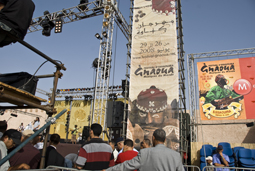
The Trio Joubran from Palestine perform a late night set in Dar Souiri, a traditional Moroccan Riad with cushions on the floor for the audience. The trio are three brothers, who were taught to play the Oud by their father, and are the first and only Oud trio in existence. Their skill is breathtaking, and they perform with an impressive passion and intensity, clearly drawn from their own experiences in their troubled homeland.
Day Two: Friday 27/06/08
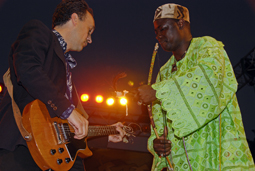 UK bluesman Justin Adams understands better than most the strong links between African music, jazz & blues. His storming performance with West African Griot Juldeh Camarah tears up the main stage in Place Moulay Hassan just as the sun sets over the sea. Adams – best known for his work with Robert Plant – first embarked on his mission to put the ‘Africanness’ back into the blues with his album ‘Desert Road’ (2001). This was followed up by the collaboration with Juldeh Camarah, ‘Soul Science’ in 2007, which won the Radio 3 ‘World Music’ award.
UK bluesman Justin Adams understands better than most the strong links between African music, jazz & blues. His storming performance with West African Griot Juldeh Camarah tears up the main stage in Place Moulay Hassan just as the sun sets over the sea. Adams – best known for his work with Robert Plant – first embarked on his mission to put the ‘Africanness’ back into the blues with his album ‘Desert Road’ (2001). This was followed up by the collaboration with Juldeh Camarah, ‘Soul Science’ in 2007, which won the Radio 3 ‘World Music’ award.
Wayne Shorter’s performance brings home very strongly the fact that the real stars of this Festival are the Gnaoua. Shorter’s quartet deliver an accomplished, lyrical set, and receive an enthusiastic response from the crowd, but when they are joined on stage by Maâlem Mohamed Kouyou & his Gnaoua group with Karim Ziad on drums, the crowd erupts into a frenzy, and the Gnaouas dominate the rest of the set. Shorter’s keyboard player, Danilo Perez delivers a faultless accompaniment to the Gnaoua beats. 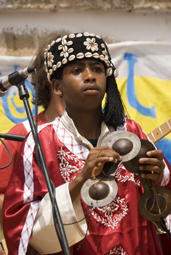
We wander round to the stage at Bab Marrakech, & find a combination of steel drums (Paris based American Andy Narell); electric guitar (Abdenour Djemaï from Algeria); violin (Hassan Idbassaid from Morocco) and percussion (Stephane Edouard; France / India) providing the accompaniment to the pounding Gnaoua rhythms of Maâlem Abderrahim Benthami. Andy Narell’s gentle steel drums sound as if they were made to be played with Gnaoua music.
Most of the invited musicians here have never played together before, and many have never played with the Gnaoua, but clearly a huge amount of thought has gone into deciding which musicians will play with each other during the Festival. One of the special things about these musicians is their intuitive ability to adapt their musical style and blend with the Gnaoua rhythms and with each other. Abdenour Djemaï observes ‘it’s all about listening; you 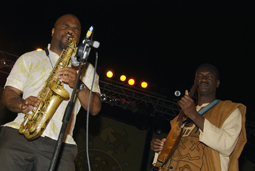 can be the best musician in the world, but if you cannot listen then you can never play with anyone else…..’
can be the best musician in the world, but if you cannot listen then you can never play with anyone else…..’
The final show of the evening confirms even more strongly this ability of Gnaoua, and this festival to bring together artists from just about anywhere in the world, when Maâlem Omar Hyat appears with Franck Vaillant (France) on drums; Mohamed Derouiche (Morocco/France) on guitar; Jon Balke (Norway), piano/synth, and multi-award winning Lebanese trumpeter Ibrahim Maalouf.
Day Three: Saturday 28/06/08
Toumani Diabate, legendary Malian kora player and the 71st generation of kora players in his family performs in Essaouira for the first time on stage with his 15 year old son, Sidiki – already clearly an accomplished kora player in his own right. The musical chemistry between the two is electric. Toumani has been playing kora from the age of five, and is recognised as one of the most important musicians in Africa today. He has played and recorded with numerous international artists and performed in over 2000 concerts and over 170 festivals.
Over on the stage at Bab Marrakech Maâlem Hamid El Kasri from Rabat stirs the crowd into a frenzy of dancing and frantic head shaking…. 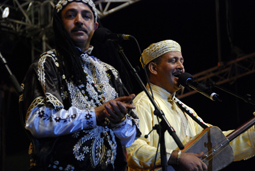 the scene is as close to the performance of a huge rock star as Essaouira gets…..
the scene is as close to the performance of a huge rock star as Essaouira gets…..
The last performance of the night on the main stage is Malian griot and n’goni player extraordinaire Bassekou Kouyate, who has played with Ali Farka Toure, Toumani Diabate and on Dee Dee Bridgewater’s recent album ‘Red Earth’. Kouyate and his band are superb, and at one point perform a storming Chuck Berry style shimmy from one side of the stage to the other, ripping out some West African rock n’ roll on their tiny n’gonis. Kouyate is joined on stage by US saxophonist Jaleel Shaw, who has appeared with various musicians throughout the Festival, and each time I have seen him he seems more and more relaxed and in tune with the Gnaoua vibe and rhythms.
After the main performances are over, the music continues until dawn, in various small squares where Gnaoua bands play to lively crowds, and act out some of the aspects of the traditional ‘lilas’, or healing trance sessions.
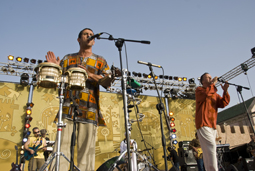 Final show: Sunday 29/06/08
Final show: Sunday 29/06/08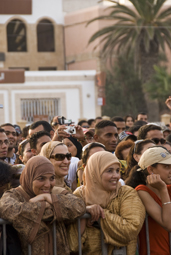
The 11th Essaouira Festival is brought to a close with a wild, joyous performance from Paris-based ‘Orchestra National de Barbes’ (ONB), fusing reggae and sub-Saharan African rhythms with a variety of styles from North Africa. ONB was formed in 1996 with the aim of creating an uplifting fusion of the various musical cultures of the band members, yet still retaining aspects of their individual styles. Group members hail from Morocco; Algeria and Tunisia and provide an appropriately joyful performance; swapping instruments and musical styles and filling the stage with an infectious energy that sets the whole of the square on fire.
As the sun sets on this years’ Gnaoua festival, I have the sensation of having shared in a piece of unique musical magic that I know will stay with me for a long time…..
© Alice Mutasa 2008
